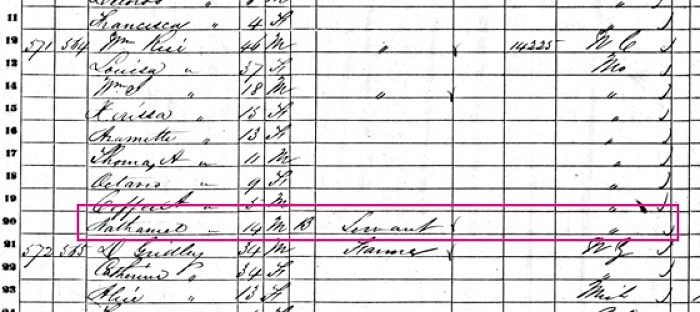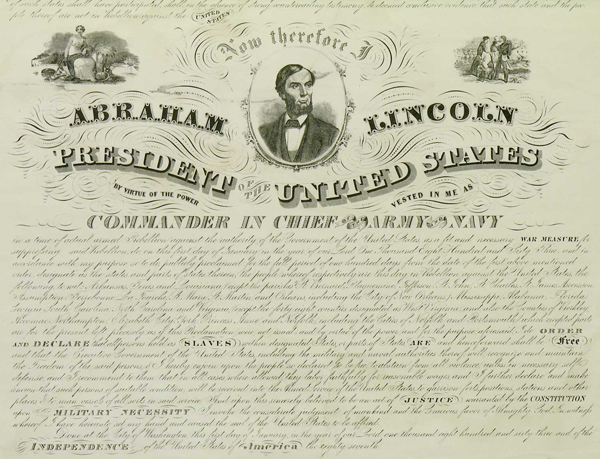African American History, Ask A Librarian, California History
Ask A Librarian: Slavery in Napa
If California was a free state, does that mean we didn’t have slaves in Napa County?
The short answer is we most certainly did have slaves in Napa, but the reasons for that are a little more complicated.
About the same time John Grider and Major Wyatt arrived in Napa (see blog “First African Americans in Napa”), John B. and Mary E. Scott sold for $9,548 their rights to and interest in 34 slaves. The transaction is often referenced as the only example of slavery in Napa County, however, there is no evidence the slaves ever left Virginia. They were sold to Charles S. Carrington, a Virginia slaveholder and farmer who would later go on to fight for the Confederacy in the Civil War. There is no evidence he left Virginia outside of the war, and it is doubtful he ever travelled to California. The Scotts were recorded in Napa on the 1860 federal census, and for whatever reason decided to have the 1845 deed from Mecklenburg County, Virginia, re-recorded in Napa in 1861. The deed states that John Scott signed the paperwork at the Virginia court, so it is probable he and Mary were still living there when the slaves were initially sold. Either way, it is highly unlikely the slaves ever set foot in Napa County.
The census records for 1850 did not record any African Americans in Napa County. That is not to say there were no Black people in the county, but that they were simply not recorded. The 1852 state census recorded nine African Americans, all but two working as laborers or servants. There were likely also slaves present, but because California was a free state, there was no option to record them. By 1860 forty African Americans were counted, with most working in domestic roles in private households or as day laborers and a few employed in skilled trades.
In 1852, Assemblyman Henry A. Crabb (no relation to Napa vineyardist H. W. Crabb) passed the Fugitive Slave Law in the state legislature, inspired by the federal Fugitive Slave Act of 1850. The Act and Law gave white Americans the ability to declare ownership over an African American as long as they could not produce papers proving their freedom. Not only did the laws not prevent slave owners from bringing their slaves to California on false promises of freedom, but there also was no limit to how long a slave owner could sojourn in California with their slaves. They also forbade African Americans from crossing state lines to escape to freedom and harshly punished anyone who either aided or failed to turn in a suspected escaped slave. Despite slavery being illegal, it was barely monitored or prosecuted, and buying, selling, and trading human chattel was frequent enough that many whites felt comfortable enough to advertise in newspapers. Making matters even more complicated, not only was no one enforcing antislavery regulations, there was no agency to recapture and return runaway slaves.
Black historian Rudolph M. Lapp estimates up to 600 Black slaves participated in the heydays of the Gold Rush, including those who were sent back to slave states before their indenture was ended. The true figures will never be known, however, as many slaveholders stashed their slaves in isolated areas so as to not attract undue attention.[i] Delilah S. Beasley, one of California’s first Black female historians, described the situation bluntly:
the majority of the white settlers at that period in California belonged to either the northern element who were opposed to slavery from principle, or they were opposed to it because they were too poor to own slaves, while the other half of the white settlers in the Territory of California were for bringing their slaves because they saw a possibility of working the mines and reaping a fortune through slave labor.[ii]
Many slaveholders tried to keep their slaves by forcing them into bondage contracts, and “Under these arrangements, enslaved people ostensibly agreed to work for a period of months or years in the mines or to make a sum of money equivalent to their purchase prices. Masters, in turn, promised to emancipate slaves once they served their terms or earned the cash.”[iii] Recording these transactions with state officials was an attempt by the masters to not only legitimize Black indenture but also to enforce contracts and discipline African Americans who tried to break them.[iv] Dozens of cases were tried in state courts, but the outcome varied depending on whether the case was held to Mexican or California rules and whether the judge was more sympathetic to Southerners or abolitionists. Nevertheless, slaves continued to escape, and free people of color and white allies alike aided them in their flight, came to their rescue in court, wrote tragic accounts of the conditions of slavery, and established active underground railroads.
Sometime in the 1850s after buying his freedom, Grider returned the favor by looking out for the welfare of four slaves held on a ranch outside of Napa City. Aaron Rice, Old Man Sours, Wash Strains, and Old Man Sydes were owned by a man down in Walnut Creek who had leased them to a Napa farmer. When Grider contacted Reverend Thomas Starr King about the human rights violation, King personally went to Napa and had the men emancipated. King was a Unitarian minister and fiery orator against slavery, and was so imposing a speaker that he once claimed, “Though I weigh only 120 pounds, when I’m mad, I weigh a ton.”[v]
What happened to three of the men next is lost to history, but Rice remained in Napa as a free man. The Rice family was brought to Napa as slaves by William Rice. Aaron and his teenage son Nathaniel had further legal troubles with William in August 1860. Aaron petitioned the county court to free his son, and an arrest warrant was put out for William Rice. The local judge ruled against Aaron, saying there was no evidence that William had illegally held Nathaniel (whose middle name, incidentally, was also William). Historian Stacey L. Smith rightfully points out that “In reality, there was probably considerable evidence of the men’s enslavement, it was just not admissible in California’s courts. The state’s refusal to allow African American testimony against whites…prevented Aaron and Nathaniel Rice from taking the witness stand.”[vi] Not only did William Rice force Nathaniel to work through the remainder of his indenture contract, he also brought perjury charges against Aaron.[vii] Eventually Nathaniel and the rest of the Rices were freed, and they stayed in Napa County at least through the 1880s.

What is especially interesting about the African Americans in the 1852 state and 1860 federal census for Napa County is where they came from. Thirty-seven percent hailed from states where slavery was legal while 63 percent were born in states where slavery was illegal. A more granular look reveals that of the latter group, only 5 percent were from places where slavery was deeply embedded (Utah Territory, Washington D.C., and South Carolina), while 61 percent came from border states (mostly Missouri and Virginia). Those from staunchly free states tended to be from Massachusetts or New York, not counting the majority who were born in California – all of whom were children three years and under.
1860 is one of the most interesting decades in terms of “types” of African Americans living in Napa. There were still slaves or indentured servants – 18 year old Charity from Missouri, 36 year old Charles with no known place of birth, and 17 year old Martha from Kentucky had no recorded surnames and were living as employees in white households. At the same time, however, pioneering Black families were finally recorded on the federal census. There are eleven families noted, with about half of the couples working in white households as free people and the rest settled on their own land.
[Ed. note: this article is excerpted in part from the master’s thesis “There Are No Black People in Napa”: A History of African Americans in Napa County by Alexandria Brown.]
[i] Rudolph M. Lapp, Blacks in Gold Rush California (New Haven, CT: Yale University Press, 1977): 65.
[ii] Delilah L. Beasley, Negro Trail-Blazers of California, (Los Angeles: Times Mirror printing and binding house, 1919): 43.
[iii] Stacey L. Smith, “Remaking Slavery in a Free State: Masters and Slaves in Gold Rush California,” Pacific Historical Review, 80, no. 1 (February 2011): 50, http://www.jstor.org/stable/10.1525/phr.2011.80.1.28.
[iv] Ibid., 51.
[v] Sally Denton, Passion and Principle: John and Jessie Frémont, the Couple Whose Power, Politics, and Love Shaped Nineteenth-Century America (Lincoln, NE: First Nebraska, 2009): 281; Beasley, Negro Trail-Blazers, 91.
[vi] Stacey L. Smith, Freedom’s Frontier: California and the Struggle over Unfree Labor, Emancipation, and Reconstruction (Charlotte, NC: University of North Carolina Press, 2013): 176.
[vii] Ibid., 176-177.


